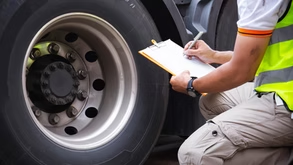When managing a transportation business, encountering a DOT violation can feel awful. Knowing what a DOT violation is and how it affects your company can help you take the right steps to protect your business and maintain safe operations.

These violations cover a broad range of infractions related to driver behavior, vehicle safety, and compliance with Department of Transportation rules. For employers and drivers alike, recognizing the consequences tied to these breaches plays a big part in maintaining operational integrity.
A DOT violation is any failure to comply with the regulatory standards established by the Federal Motor Carrier Safety Administration (FMCSA). These can range from issues discovered during a DOT safety inspection to non-compliance with DOT drug testing policies.
The ripple effects of a single violation can extend beyond immediate fines or penalties, influencing insurance costs, driver qualifications, and company reputation. Businesses that know the scope and impact of DOT violations are better prepared to act swiftly and decisively when problems arise.
Types of DOT Violations
DOT violations cover many aspects of transportation safety and compliance. Common examples include driver-related infractions such as hours-of-service violations, failing a drug or alcohol test, or driving without a valid commercial driver’s license.
Vehicle-related violations often emerge from safety inspection failures, such as malfunctioning brakes, worn tires, or defective lighting systems. Violations might also arise from administrative errors like incomplete driver qualification files or missing records of DOT drug testing.
Identifying specific violation types is important because different infractions carry different consequences. Some DOT violations may trigger immediate roadside penalties, while others lead to investigations or audits that can result in longer-term impacts on your business’s operating authority.
How DOT Violations Are Discovered
Many DOT violations surface during routine or surprise DOT safety inspections. These inspections might be conducted at weigh stations, during roadside stops, or at the company’s yard.
Inspectors use standardized checklists to identify non-compliance with FMCSA regulations, looking closely at vehicle safety equipment and driver credentials.
Some violations become known through reports filed by other drivers, employees, or even the public. For instance, failures in DOT drug testing compliance can be flagged if test results are not reported correctly or if a driver refuses testing.
Employers have a responsibility to maintain records and report violations promptly. Tools such as a DOT violation search can help companies monitor their compliance history and prepare for upcoming audits.
The Business Impact of DOT Violations
A DOT violation can create a cascade of challenges for a transportation business. Beyond fines or penalties, repeated or serious violations can lead to operational restrictions, loss of operating authority, or increased scrutiny from regulators.
Insurance providers often react to DOT violations by raising premiums or limiting coverage, which adds financial pressure.
Driver morale and retention may suffer if violations result in disciplinary actions or disqualification from driving duties. When drivers face suspensions or removal from service due to DOT drug testing failures or other violations, companies must scramble to fill positions and maintain schedules.
Public and customer perception also plays a part. A business known for accumulating DOT violations may struggle to win contracts or maintain relationships with clients. Conversely, companies that prioritize compliance often enjoy a stronger reputation and can use their safety records as a competitive advantage.
Reporting and Tending to DOT Violations
When a DOT violation occurs, it is important to act quickly. Employers are required to report certain violations within specified timeframes to comply with FMCSA rules. This includes reporting drug and alcohol testing results and any driver disqualifications resulting from violations.
Knowing how to report a DOT violation accurately and timely is part of maintaining good standing with regulatory agencies. Failure to report or delayed reporting can itself become a violation, compounding business risk.
Companies often use DOT compliance services to help manage reporting and documentation tasks, so all obligations are met on schedule.
After a violation is reported, companies should take corrective action, which may involve retraining drivers, repairing vehicles, or revising operational policies. Tracking progress and outcomes can reduce the chance of repeated violations and demonstrates a commitment to safety.
The Role of DOT Compliance Services
Handling DOT violations and related regulatory requirements can be complex. Partnering with experienced DOT compliance services offers a way to manage these challenges effectively. Compliance providers assist with everything from conducting proper DOT drug testing to preparing for DOT safety inspections.
They also offer support for managing records, submitting reports, and conducting internal audits to identify potential risk areas before regulators do. Using professional services helps businesses maintain compliance more consistently and reduces the stress on internal teams.
Monitoring and Using DOT Violation Data
One valuable tool for companies is the DOT violation search feature available through government databases or third-party providers. This allows businesses to review their own violation history or check on new infractions as they arise. Monitoring this data helps companies spot trends or recurring issues.
Reviewing violations systematically also supports better decision-making in hiring, training, and maintenance scheduling. By grasping the root causes of violations, businesses can implement focused improvements and reduce future risk.
Training and Prevention Strategies
Many DOT violations stem from misunderstandings or lapses in following procedures. Investing in regular driver and staff training reduces these risks significantly. Training should cover regulations, proper reporting, and the consequences of violations such as failed DOT drug testing or missed DOT safety inspections.
Developing clear policies and reinforcing a culture of safety also encourage employees to report issues proactively rather than hiding them. Prevention is often less costly than reacting to violations, which makes this an important area of focus.
Realizing the Impact of DOT Drug Testing Violations
One specific type of violation that carries serious weight involves DOT drug testing compliance. Drivers who fail a drug or alcohol test face immediate removal from safety-sensitive duties until they complete a return-to-duty process.
Employers are responsible for maintaining accurate testing records and reporting any violations to the federal clearinghouse.
Failing to meet these obligations can result in significant penalties and place the company’s operating authority at risk. Staying current on drug testing rules and managing documentation carefully helps minimize this risk.
The Financial Consequences of DOT Violations
Penalties associated with DOT violations differ depending on severity but often include hefty fines. In some cases, multiple violations lead to escalating fines or operational restrictions. Companies may face indirect costs too, such as higher insurance premiums or lost business opportunities.
Repairing vehicles or retraining drivers also carries costs, and repeated violations can impact long-term financial stability. Taking care of violations swiftly and maintaining good compliance records helps control these expenses.
Legal Implications of DOT Violations
Ignoring or mishandling DOT violations can lead to legal consequences beyond regulatory fines. Violations involving driver safety or drug testing failures may open businesses to lawsuits, especially if accidents or injuries occur.
Maintaining proper documentation and following reporting protocols supports legal defense if challenges arise. Engaging knowledgeable counsel and DOT compliance services can protect your business interests during investigations or disputes.
How to Report a DOT Violation Correctly
Knowing how to report a DOT violation begins with knowing what incidents require reporting and who is responsible. Employers must report positive drug or alcohol test results, refusals to test, and violations that lead to driver disqualifications.
Reports are typically submitted through federal clearinghouse systems or directly to FMCSA, depending on the nature of the violation. Keeping clear and organized records supports accurate reporting and reduces errors.
Preparing for DOT Safety Inspections
Anticipating DOT safety inspections helps reduce the likelihood of violations. Routine vehicle maintenance, keeping driver qualification files up-to-date, and regular internal audits can reveal potential issues before inspectors do.
Scheduling mock inspections or engaging DOT compliance services offers businesses another layer of preparation. A proactive approach to inspection readiness lowers the chance of penalties and operational disruptions.
Rebuilding After a DOT Violation
Recovering from a DOT violation requires a thoughtful approach. Companies should analyze what led to the violation and adjust policies or procedures to prevent recurrence.
Supporting affected drivers through rehabilitation or training reinforces safety standards. Documenting all corrective measures taken strengthens the company’s position with regulators and customers.
How Express Compliance Can Support You
At Express Compliance, we specialize in helping businesses handle the complexities of DOT violations and maintain strong safety records. Our team brings expertise in managing DOT drug testing, preparation for DOT safety inspections, and all aspects of clearinghouse compliance.
We work closely with you to identify potential risk areas and tailor solutions that fit your operational needs.
Our goal is to simplify compliance management, allowing you to focus on running your business confidently. From assisting with DOT violation searches to guiding you through accurate reporting and recordkeeping, Express Compliance stands by your side every step of the way.
Being aware of the impact a DOT violation can have on your business is just the beginning. With our support, you can develop proactive strategies that protect your company, your drivers, and your reputation.
If you want to learn more about how Express Compliance can help you maintain a clean record and work through federal regulations effectively, don’t hesitate to get in touch today.






